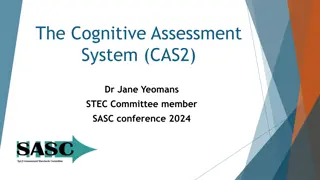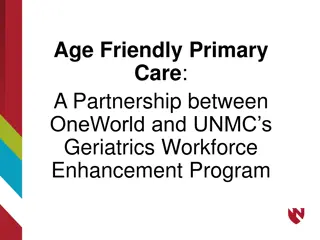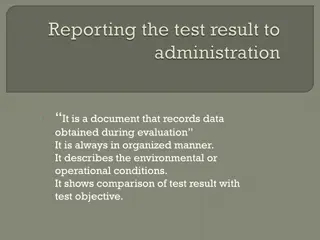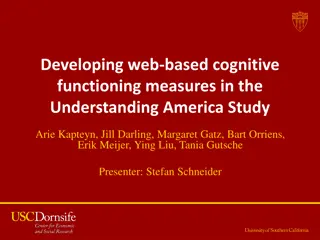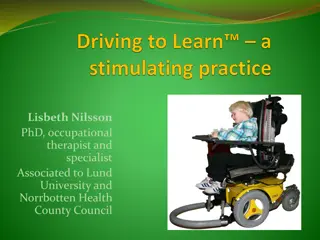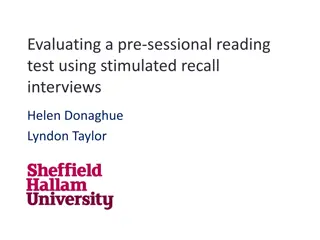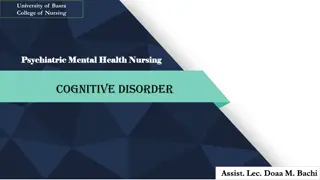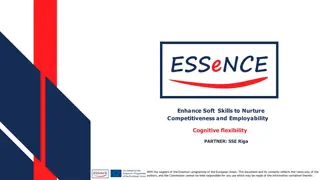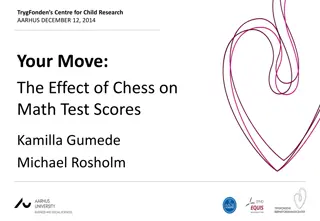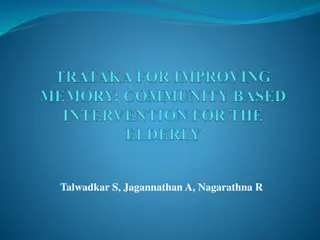Understanding Cognitive Abilities Test (CogAT) for Educational Planning
The Cognitive Abilities Test (CogAT) is a benchmark test administered to third-grade students in the WCPSS for educational planning. The test measures verbal reasoning, math reasoning, and visual-spatial reasoning skills through different subtests and composite scores. These scores help in predicting student achievement in various subjects like mathematics, reading, and language arts. The test results also provide national age scores and percentile rankings. Individual student profiles are accessed by educational programs within the school system for tailored planning and support. Profile codes indicate the student's cognitive strengths and areas for development, guiding educators in creating effective learning strategies.
Download Presentation

Please find below an Image/Link to download the presentation.
The content on the website is provided AS IS for your information and personal use only. It may not be sold, licensed, or shared on other websites without obtaining consent from the author. Download presentation by click this link. If you encounter any issues during the download, it is possible that the publisher has removed the file from their server.
E N D
Presentation Transcript
Cognitive Abilities Test (CogAT) Understanding the Student Profile and its Use for Educational Planning
Educational Planning The Cognitive Abilities Test (CogAT) is administered to all third grade students in WCPSS. The CogAT benchmark testing is used for educational planning. Individual student data is accessed by the Academically or Intellectually Gifted (AIG) Program and other WCPSS educational programs.
CogAT Scores Please refer to the sample CogAT Report included with the meeting hand-outs. The CogAT Batteries are: Verbal measure of verbal reasoning skills Quantitative measure of math reasoning skills Nonverbal measure of visual-spatial reasoning
CogAT Composite Scores The Quantitative-Nonverbal Partial Composite (QN) combines the three Quantitative subtests and the three Nonverbal subtests. This composite score better predicts achievement in mathematics. The Verbal-Nonverbal Partial Composite (VN) combines the three Verbal subtests and the three Nonverbal subtests. This composite score is a good predictor of achievement in reading and language arts. The Full Composite (VQN) indicates the overall strength of the student s cognitive resources for learning.
National Age Scores Stanine a type of normalized standard score scale ranging from 1 to 9 with 5 being the mean (average). Percentile indicates the percent of students in the representative age group who obtained lower raw scores on the test.
Graphs and Profiles A bar graph of the student s scores appears on the score report as a visual representation of the student s percentile score. Your student s individual profile code is listed after the subtitle Ability Profile . Additional information regarding your child s profile can be found at: www.cogat.com by keying in the profile code of your student.
Profile Codes The profile code contains a number and a letter, for example, 8E (V-N+) or 7B (V+). The number represents the median stanine and the letter indicates the type of score pattern. The letter score patterns are: A, B, C or E.
Percentile and Stanine Descriptions Description Very High Above Average Above Average Average Average Average Below Average Below Average Very Low Percentile 96-99 89-95 77-88 60-76 41-59 24-40 12-23 5-11 1-4 Stanine 9 8 7 6 5 4 3 2 1
Student Profiles A Profile all subtest scores are roughly the sAme B Profile one subtest score is either aBove or Below the other two subtest scores C Profile two subtest scores Contrast indicating a relative strength and a relative weakness E Profile the difference between the high and low subtest scores is Extreme
Raw Scores Number of Items = the number of questions on the subtests. Number Att. (attempted) = the number of questions the student answered. Number Correct = the total number of items the student answered correctly.
National Grade Scores The grade scores compare the student to other students at the same grade level nationally. Grade scores are NOT used for identification since students in a given grade may vary greatly in terms of their age.
The Next Step.. Students with an age-based Composite or subtest battery score at or above the 85th percentile (85%) are eligible to take the Iowa Assessments (Iowa). Parents will receive a permission form that must be signed and returned to the school before the student can take the Iowa.
AIG Identification The CogAT and Iowa scores are reviewed. Additional factors (Informal Indicators) are considered in determining AIG eligibility. These factors include student interest, motivation, classroom performance, third grade Explorers work samples, parent and teacher checklists, etc. The overall profile of the student is considered in the overall identification process.
Additional Steps in the AG Identification Process School Based Committee for Gifted Education (SBCGE) meets to nominate and refer students. Parents sign and return the Consent For Evaluation. Formal and Informal data are compiled. SBCGE makes final recommendations for reading and/or math identification and level of service.
AIG Identification Process continued. SBCGE recommendations from schools are reviewed by the AIG Program Central Services Committee. Parents are informed of the final AIG recommendations during 2ndsemester. AIG service begins in the second half of the 3rd grade year after the ISP has been approved and parents sign and return the Initial Consent for Service.
AIG Program and Testing Information Test Coordinator: Valerie Cooper School Counselor: Cindy Natale 3rdGrade Classroom Teachers: Courtney Small, Katherine Belcher, Jennifer Wendt, Lauren Bryant, Bridgette Bryson AIG Resource Teacher: Laura Pigg AIG Parent Guide AIG Program Website: http://www.wcpss.net/curriculum-instruction/ag/ AIG Program Office: Crossroads 1 5625 Dillard Drive Cary, NC (919) 533-7021




